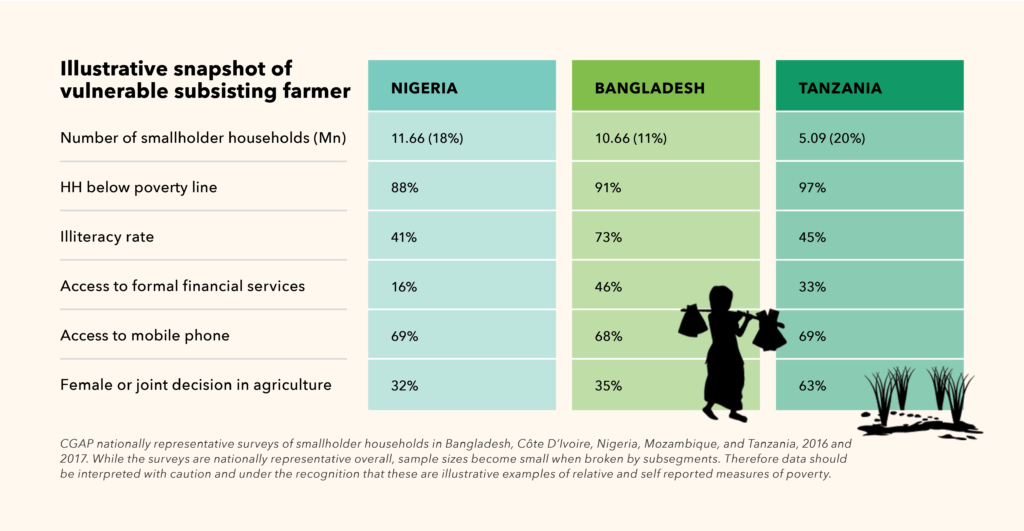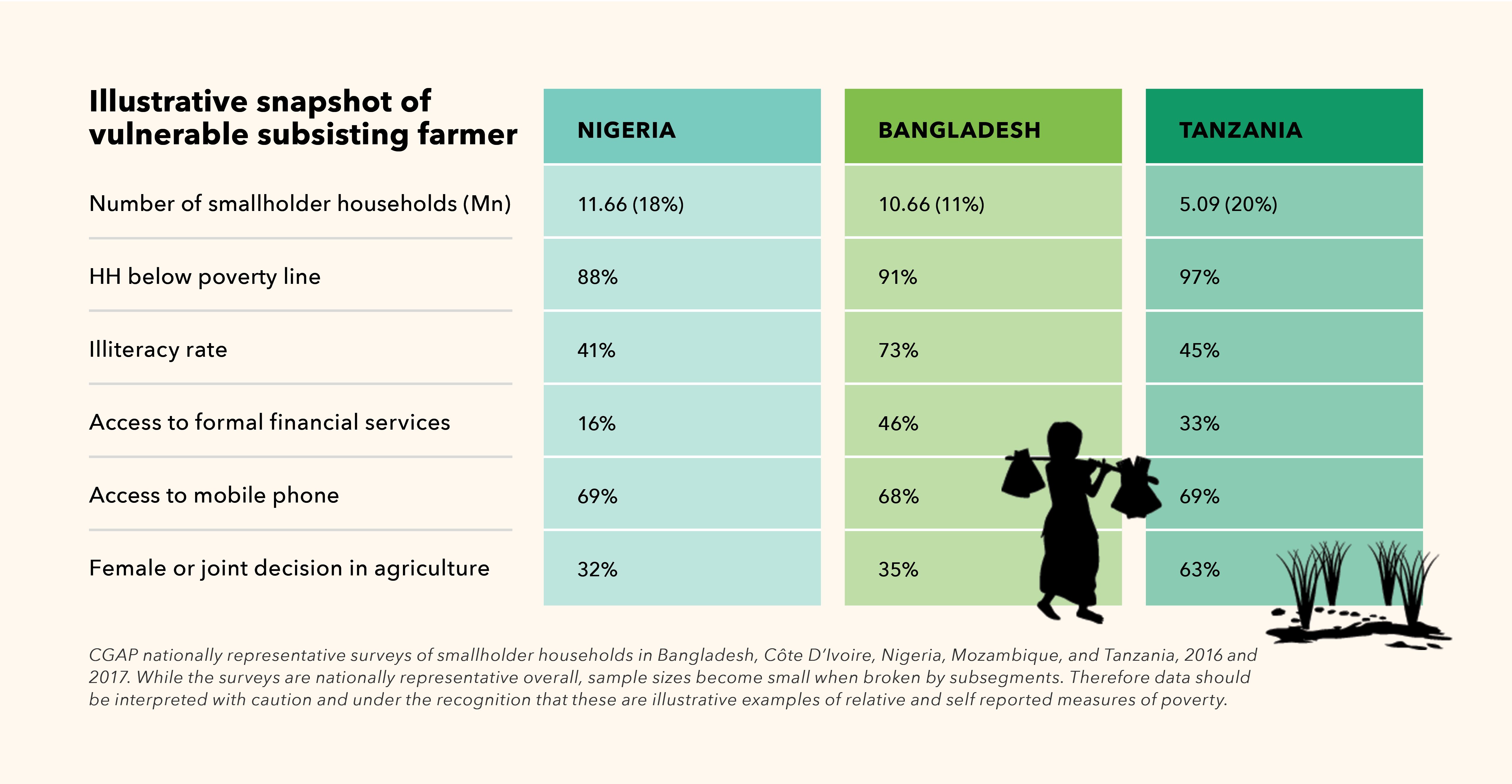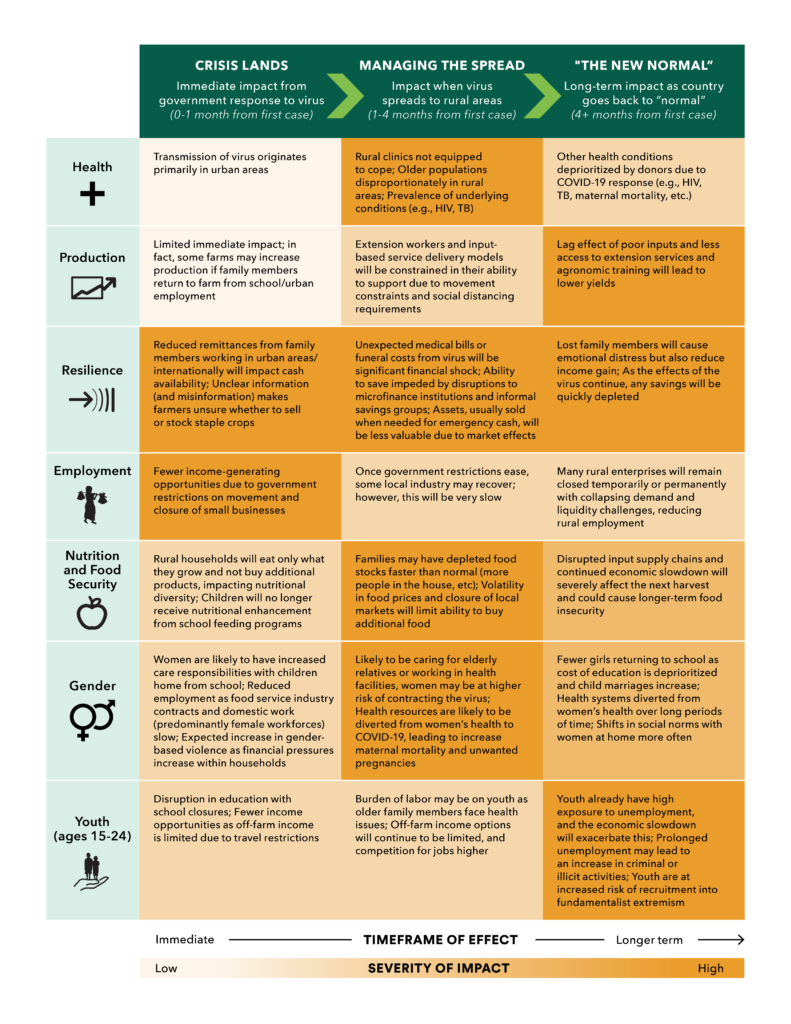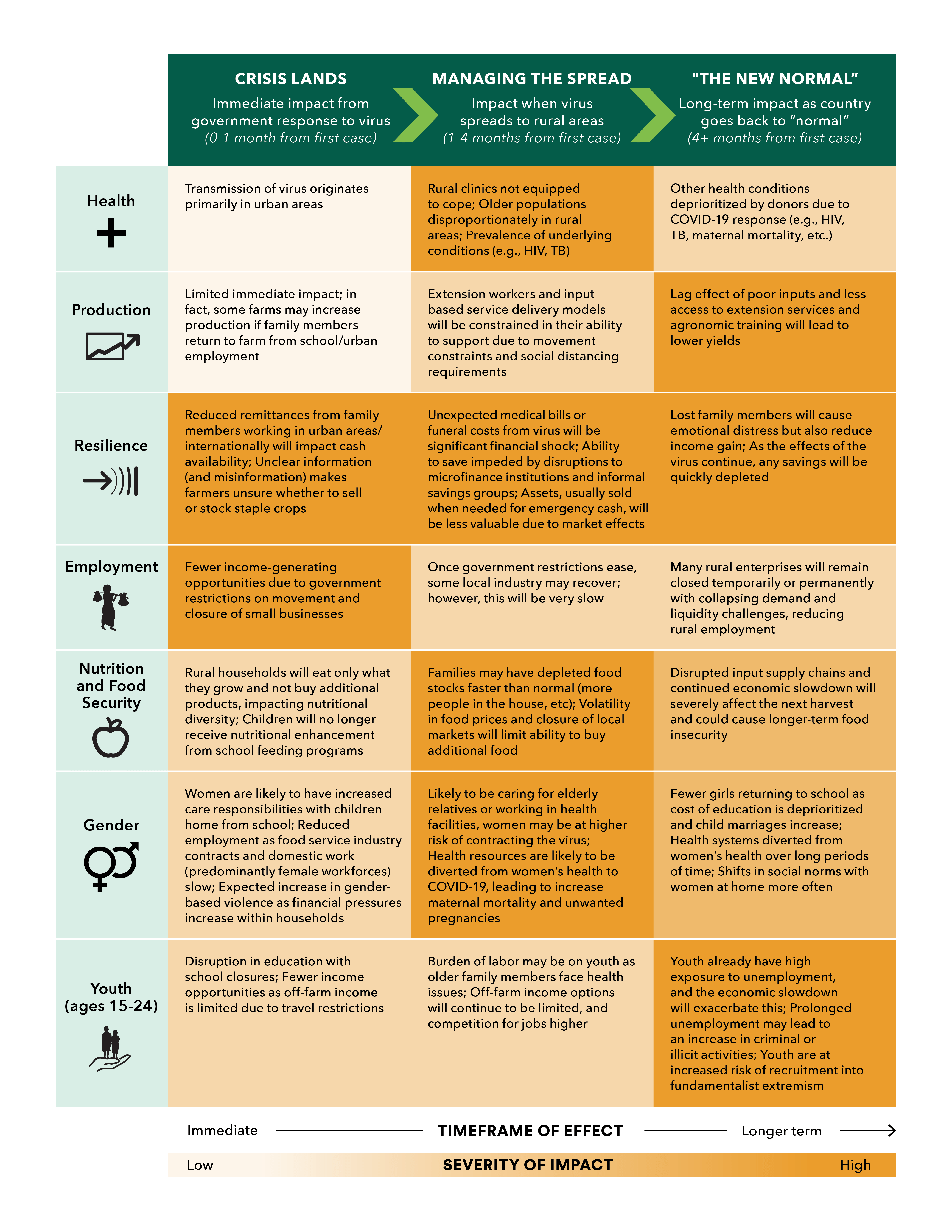Briefing 2
Vulnerable households at the edge of the pandemic: Pathway 1
Smallholder farmers in Pathway 1 are in a subsistence state, often farming less than one hectare with little or no surplus for trade. As illustrated below, these farmers are likely to live below the poverty line, with limited access to financial services. These farmers typically do not farm as a business; their farm income is supplemented with other non-farm sources, social networks, and government or donor assistance. Many subsistence farmers do not wish to remain in farming. Others have ambitions to generate increased income from the farm, but lack the tools necessary to increase volume and production value, as well as the tools needed to combat risks of adverse effects such as droughts and pests. These farmers rely on an ecosystem of rural infrastructure, local input markets, and government extension services or donor programs for their livelihoods. Primary service needs for this pathway include access to basic inputs (typically subsidized or partially subsidized), training on agronomic practices, simple farm technologies, and funeral/health insurance.
For rural households, the immediate impact of the crisis is not a direct health impact, but rather an indirect economic impact. The virus has originated primarily in urban centers, and government responses have focused on containing the virus and “flattening the curve” as much as possible. If the virus spreads to rural areas — as it has already done in some geographies — weaker health systems may cause the direct impacts of the virus to be felt more acutely, compounding the indirect economic impacts. In the long term, whether the virus spreads to rural areas or not, it is likely that food systems will be disrupted and economic challenges will continue, particularly impacting vulnerable rural households.
Crisis lands: Immediate impact from government response to virus (0-1 month from first case)
COVID-19 has spread through person-to-person transmission, and in most countries this means it has originated in urban areas via people returning from overseas travel. Thus, in the initial weeks of the virus arriving in a country, subsistence farmers are less directly at risk. They are, however, immediately vulnerable to the prevention measures implemented by government officials (e.g., social distancing, lockdown, etc.) and to the subsequent economic downturn.
Managing the spread: Impact when virus spreads to rural areas (1-4 months from first case)
Once the virus has arrived, social distancing outside the home may be easier in rural areas, but risks within the home remain. Subsistence farmers tend to have limited space in a home for self-isolation and lack access to running water and sanitation facilities. In Tanzania, for example, only 2% of subsistence farmers have access to running water in their home. If/when the virus spreads to rural areas, there may be a loss of productivity due to sick family members. Rural health clinics will be less equipped to manage COVID-19 patients.
“The new normal”: Long term impact as country goes back to “normal” (4+ months from first case)
The average age and health status of subsistence farmers makes them particularly vulnerable to the physical impacts of COVID-19. The potential loss of family members, particularly the head of household, is likely to create trauma and financial disruption that can take years to recover from. The lagging emotional effects of loss, depletion of savings on medical bills and funeral costs, persistent health issues, and disruption of farming seasons is likely to take families below the extreme poverty line.
Rural economies may lag behind more urban areas in re-opening, creating a longer term recovery horizon. This slower reopening will impact the ability of subsistence farmers to earn additional income through day laboring, and may impede the provision of seeds and inputs at critical planting times. Disruptions will also have long-term food security implications as smaller yields create food shortages in families. When these effects occur across whole communities, traditional support networks — such as savings and religious groups — may be disrupted, further destabilizing communities.
We believe an immediate and considered response that specifically addresses the needs of vulnerable subsisting farmers is critical. More than almost any other constituency in the developing world rural subsistence households risk becoming the invisible victims of the health and economic impacts of COVID-19.
The long-term strategy to support vulnerable subsisting farmers is highly dependent on what happens in the immediate and short-term waves of this crisis. Unlike other pathways, subsistence farmers are less integrated into formal markets and structures. This creates a need for more direct interventions to ensure they have the resources, support, and access needed to withstand the health and economic shocks the virus will bring.
If vulnerable subsisting farmers are not sufficiently prioritized in early responses, there is a risk that families will move further back into extreme poverty, precipitating rural food crises and instability. Governments and donors must be prepared to support subsistence farmer livelihoods as they adjust to a “new normal” that in the best case involves prolonged mask wearing and handwashing, but in the worst case leads to significant food insecurity and national instability.
PITFALL #1: Treating the most vulnerable as a general national constituency, not recognizing the specific challenges of protecting rural communities from COVID-19.
- ACTION NEEDED: National planning for supporting subsistence smallholder households connected with district and sub-district implementation, driven by governments and supported by donors.
PITFALL #2: Moving slow and going low on rural social safety net programs, leaving the most vulnerable constituency without any support.
- ACTION NEEDED: Access to large relief funds and broad-based social security rolled out through existing last mile distribution infrastructure, often through new and innovative partnerships.
PITFALL #3: Turning a blind eye to other rural crises and creating a catastrophic convergence of effects.
- ACTION NEEDED: Concurrent funding and management of other rural crises that will coincide with the COVID-19 outbreak.
PITFALL #4: Shutting down critical agricultural arteries and last mile capillaries, priming rural areas for a nutrition and food security crisis.
- ACTION NEEDED: Hyper-localized management of critical agricultural trade and commerce to protect food access, including public food reserves.
PITFALL #5: Not protecting microfinance and other last mile financing institutions, leading to a collapse in vulnerable rural credit markets.
- ACTION NEEDED: Careful government treatment of last mile credit lines and protection of financial access for the most vulnerable.





